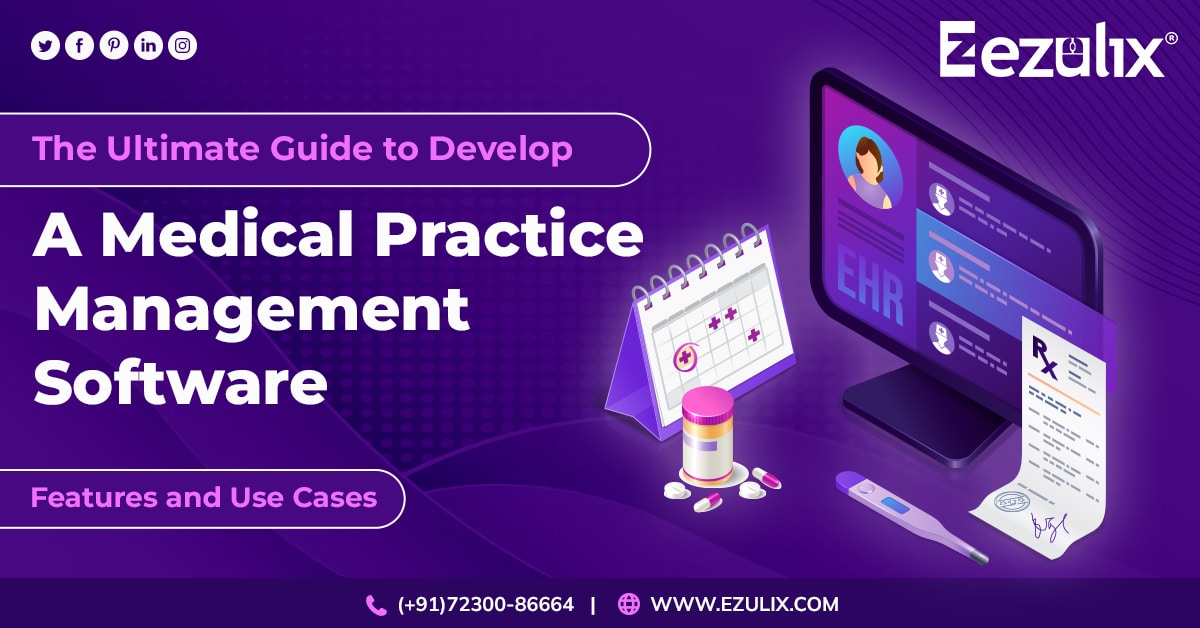Technology has now become a crucial part of every Industry. The healthcare industry is evolving quickly. It is a sector that has not escaped the need for digital change, particularly with the rise of telehealth choices. The administrative operations in hospitals, health centres, clinics, and other places have been extremely needed. No matter the size of the medical company, be it a physician’s clinic or a huge multi-specialty hospital. When doctors are hustling in OTs to save the lives of their patients, meanwhile someone has to keep the records of the business operations. A responsible one to manage the daily tasks, from admission, bed, and staff management is payble for the services offering. In recent times, several problems have prevailed around us, so managing every task is sometimes non-manageable. Thus, this generates the need for medical management software for non-clinical operations. 
What is medical practice management software?
All the coordination, streamlining, and automation of the administrative tasks of the hospital, clinic, or healthcare centres are now being controlled by the medical practice management software. This helps doctors and other staff to work effectively and efficiently without panicking about the work being. The tool is mostly used by non-medical staff members like administrators and receptionists. A complete system incorporates Operations in the front office, such as scheduling patients and checking insurance, and operations in the back office, such as financial analysis, reporting, and medical billing. When appropriately applied, technology helps minimize human mistakes, monitor financial status, and guarantee high standards of patient care. But to produce the best results, the practice management solution must function as a crucial component of the entire health IT infrastructure, closely collaborating with two other crucial pieces of software: an electronic health record (EHR) system and a patient portal. 
A patient portal is an online tool that helps you manage your health care. This online tool helps you track your healthcare provider visits, test results, billing, prescriptions, etc. On the other hand, an electronic version of a patient’s medical history, maintained over time by the healthcare provider, is known as an electronic health record (EHR). An EHR may contain all the administrative and clinical data relevant to that person’s care under a specific provider, such as demographics, progress notes, issues, medications, vital signs, past medical histories, immunizations, laboratory results, and radiology reports. The EHR automates information access and has the potential to make the clinician’s workflow more efficient.  
Features of the Medical Practice Management Software
Now after understanding the definition and getting enough elaboration on the purpose of the medical management software, not let dive into the features of the software, some of which are here below:
Patient Information Handling
The online system makes it simple for medical professionals to enter, locate, and access patient data, including demographics, medical history, or the causes of prior visits. Employees can also create and customize templates for registration forms, treatment plans, and other documents. Making and updating notes that administrators or doctors can leave for themselves or their colleagues is another function.
Arranging the Timetable 
Among the variety of benefits, the basic and important one is scheduling. This feature of calendar management helps the operational staff to match the schedule of the doctor and the patients so that it does not collide with the other one. It helps them to fix appointments for checkups, revisit, or regular medical consultancy; along with this, the patient interface helps them to select their preferred slot as per their convenient date and time. Except this, it allows sending reminders of the fixed appointment to maintain the regularity and efficiency of the hospital. 
Ability to Claim Insurance
When a patient books an appointment, the staff must check their insurance coverage before a doctor’s appointment to see if they cover the necessary treatments. If done in offline mode, this process requires phoning insurance companies or entering numerous websites if done manually. This module automates much of the routine, quickly locating all necessary information. In the insurance industry, eligibility verification is a typical use case for robotic process automation.
Invoicing 
It is a crucial characteristic that chooses to manage medical billing internally rather than contracting out to outside firms. It assists staff in timely and accurately submitting claims to payers, reducing the number of denials and accelerating reimbursement. This component frequently includes simple automated assisted coding capabilities. The most typical illustration is a code-cleaning tool that scans claims for common mistakes and raises problems. But remember that to align diagnoses, medication recommendations, and procedures with sector-specific data standards, you must hire a certified coder if you intend to bill using your practice management system. Billing on the software seems easy until an individual uses it on the real-time interface.
Elimination of Human Errors 
In today’s fast & scheduled world, making minor mistakes is normal. But, the same mistake in the healthcare industry can lead to major outcomes; that’s why integrating an automated system that helps reduce these errors and enhances the work process is necessary. The software automatically fixes spelling mistakes and other manual errors in the data, allowing patients to update their personal information regularly. You can efficiently and accurately maintain up-to-date patient records around the clock from manual paperwork converted to digital records through documentation modules.
Saving time
Utilise automated systems to boost workplace productivity and enhance cognitive processes, which are crucial for the smooth operation of your healthcare organization. To free up time for other important duties, including patient care delivery, appointments, and patient-physician communication, automation helps eliminate many tedious, difficult, and time-consuming everyday tasks.
Analytical Reports
The medical practice management software offers details on financial metrics that is useful to build financial reports and monitor profitability. Accounts Receivable (A/R) represents the sum that clients and insurance providers owe an amount to your institution for the services rendered; Days in A/R represent the typical time it takes a hospital or clinic to reimburse. By monitoring these measures, the practice can keep track of its financial status and move quickly to improve it.
Use Cases of the Medical Practice Management Software
Pharmaceutical Businesses
In pharmaceutical businesses, we use a web-based back-office inventory management system to maintain the records of the goods coming in and going out. This strategy enables the pharmacies with easy-to-use back-end development integrating third-party APIs, quality assurance, and many other major benefits for business optimization. The foremost requirements of pharmaceutical management software are:
- Rapid and automated interface for business processes to distribute the medications quickly. Whether retailing it from a store or delivering it to the customer’s home.
- Computerized generation of invoices and documents for the import and export of bulk products.
- Integration of AI or ML to recognize the voice or image to convert it into reports and generate the required documents.
- Enabling notification and alert systems for the staff and medical representatives to mechanize the schedule.
Nursing Services
This is the services-based use case of the medical management software which includes providing nursing facilities to critical patients. It is a mobile/web-based medical practice management platform that maintains the foundational job management system for nursing staff members. The foremost requirements of nursing staff management software are:
- This helps the HR department with back-office operations. For instance, like maintaining the financial reporting and leave and time management of the nursing staff.
- Distinctive mobile application for the nurses and healthcare representatives and the management to cope with different groups according to their services and areas of work.
- A secure website that only nursing staff and authorized medical personnel may access and use for clinical purposes.
Final Words –
Your ability to provide better patient communication is crucial that patients’ requirements are continuously changing. Utilizing a practice management system is a great way to increase operational effectiveness and prompt reimbursement rates. Therefore, be sure to make an investment in the best healthcare management software if you want to increase the productivity and friendliness of your clinic. Why not try it yourself by clicking the link below, filling out your information, and submitting it to us. So that our medical practice management software experts can connect with you and showcase our services.
![]()

